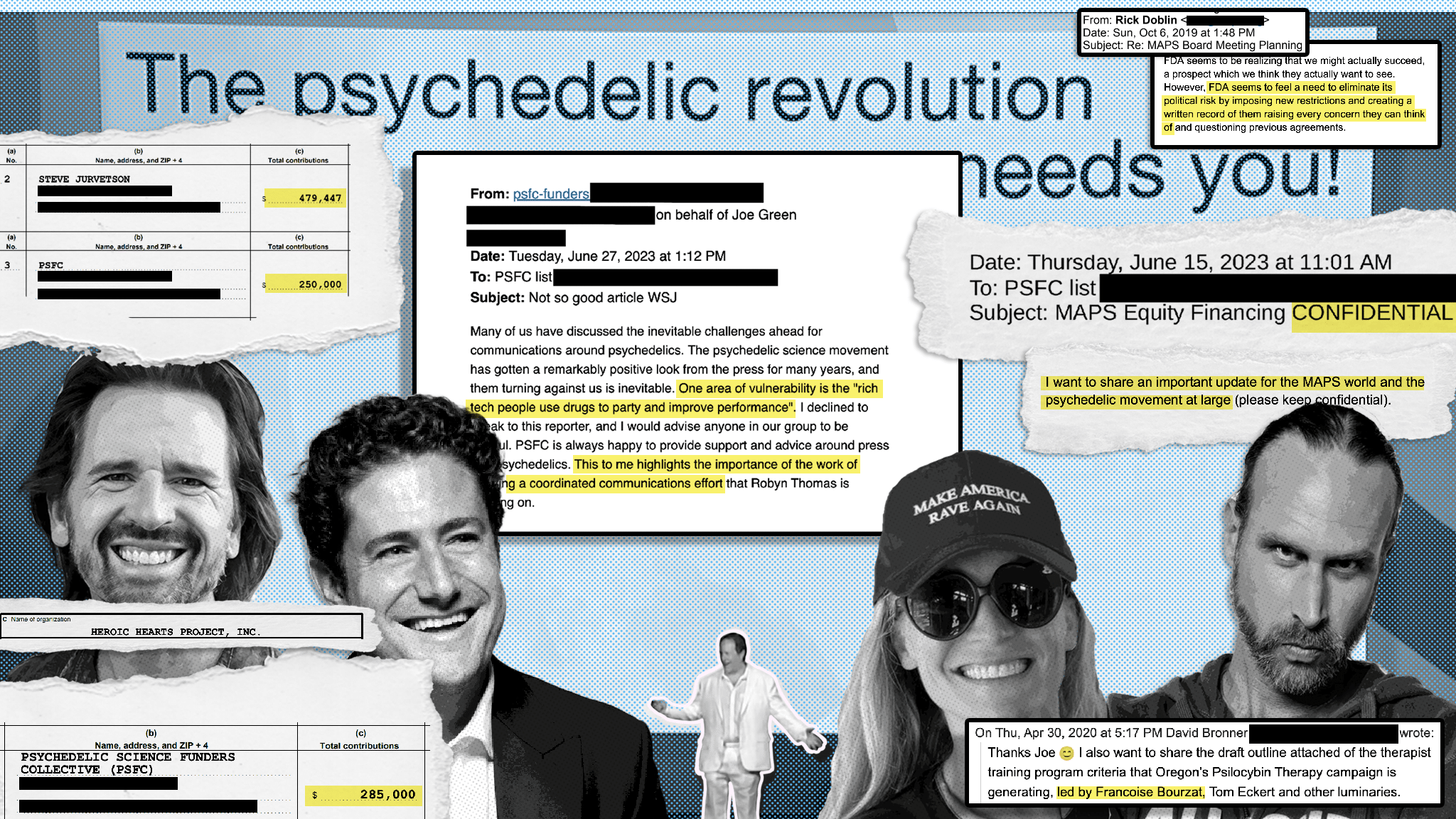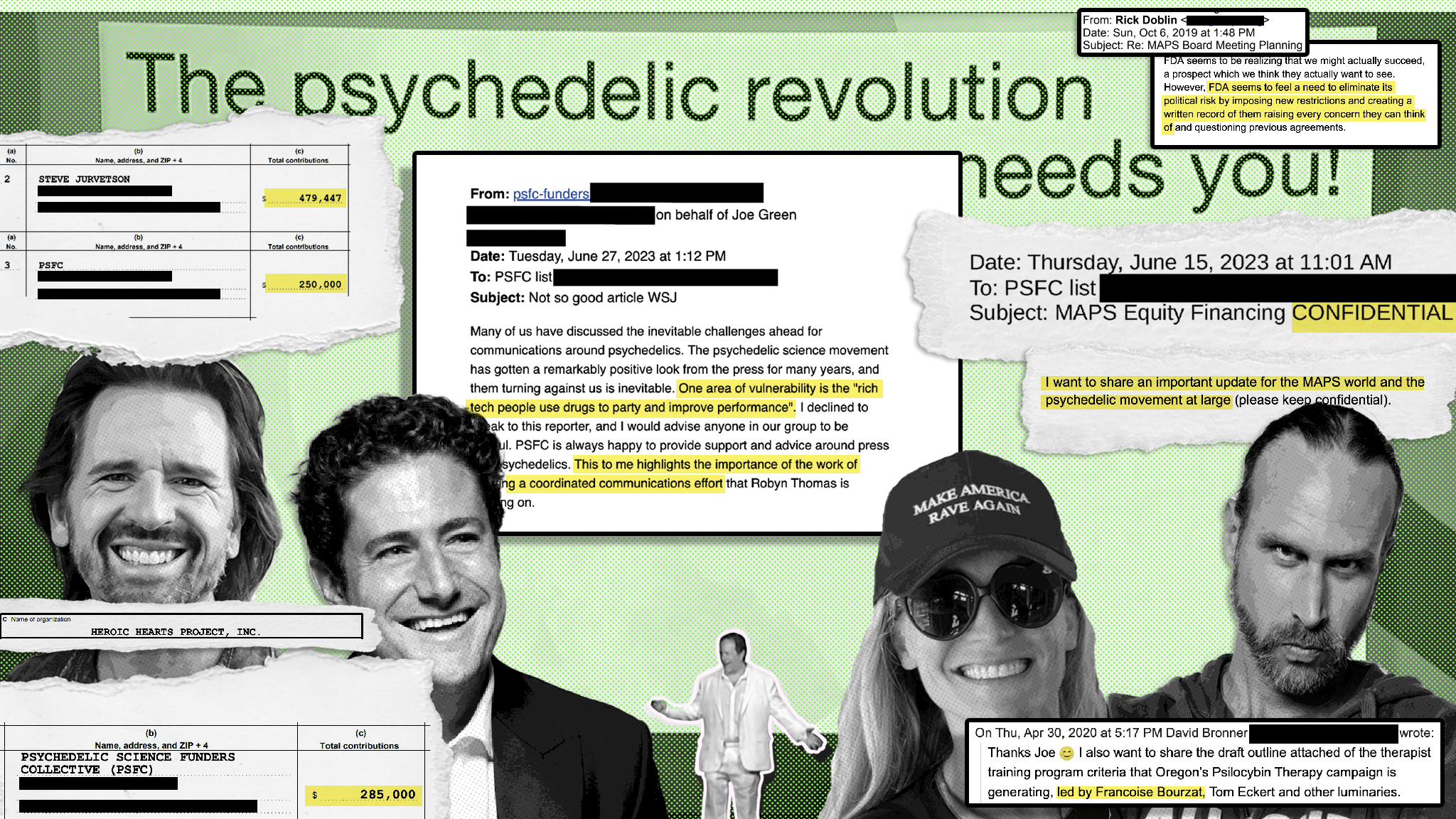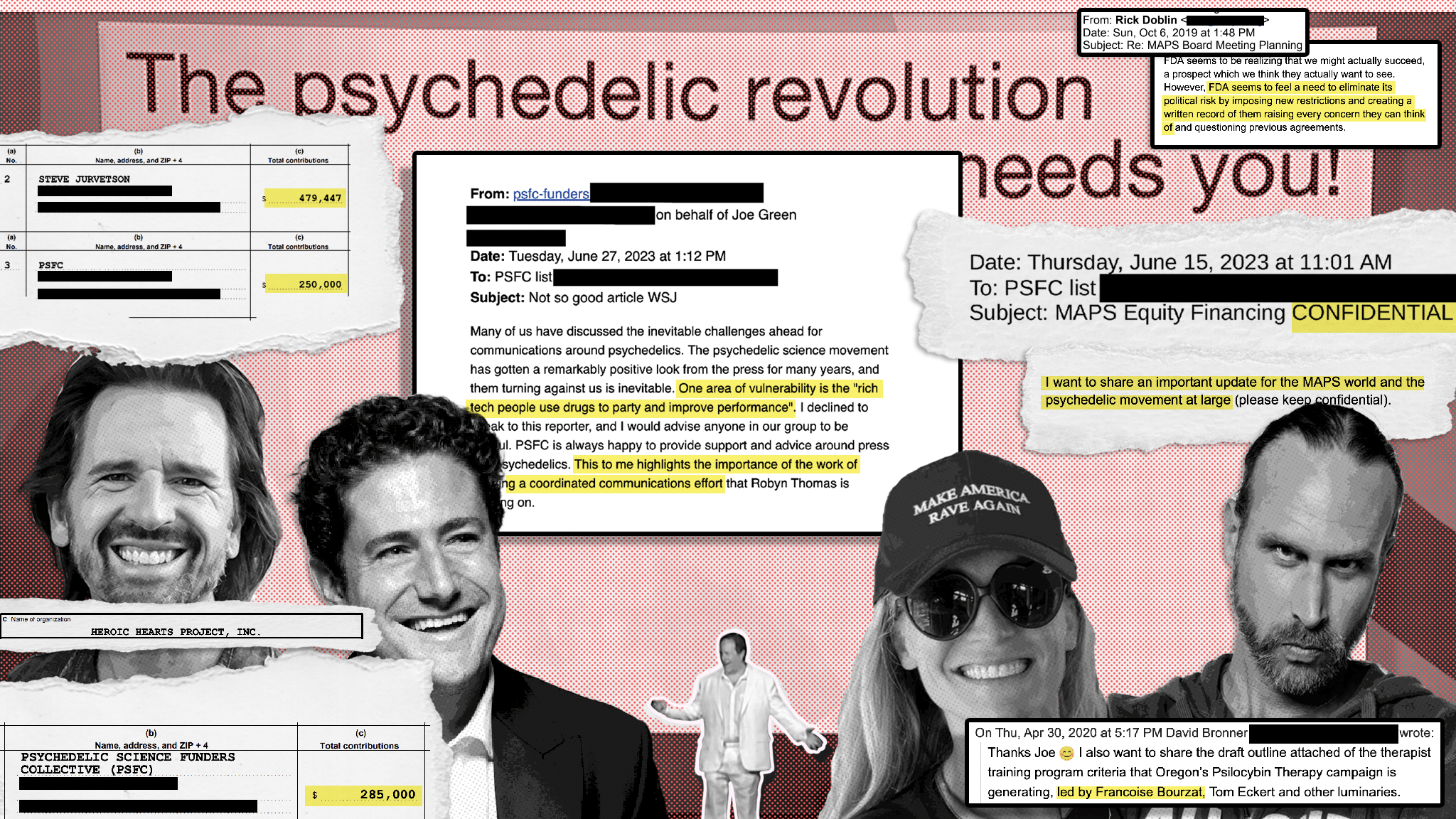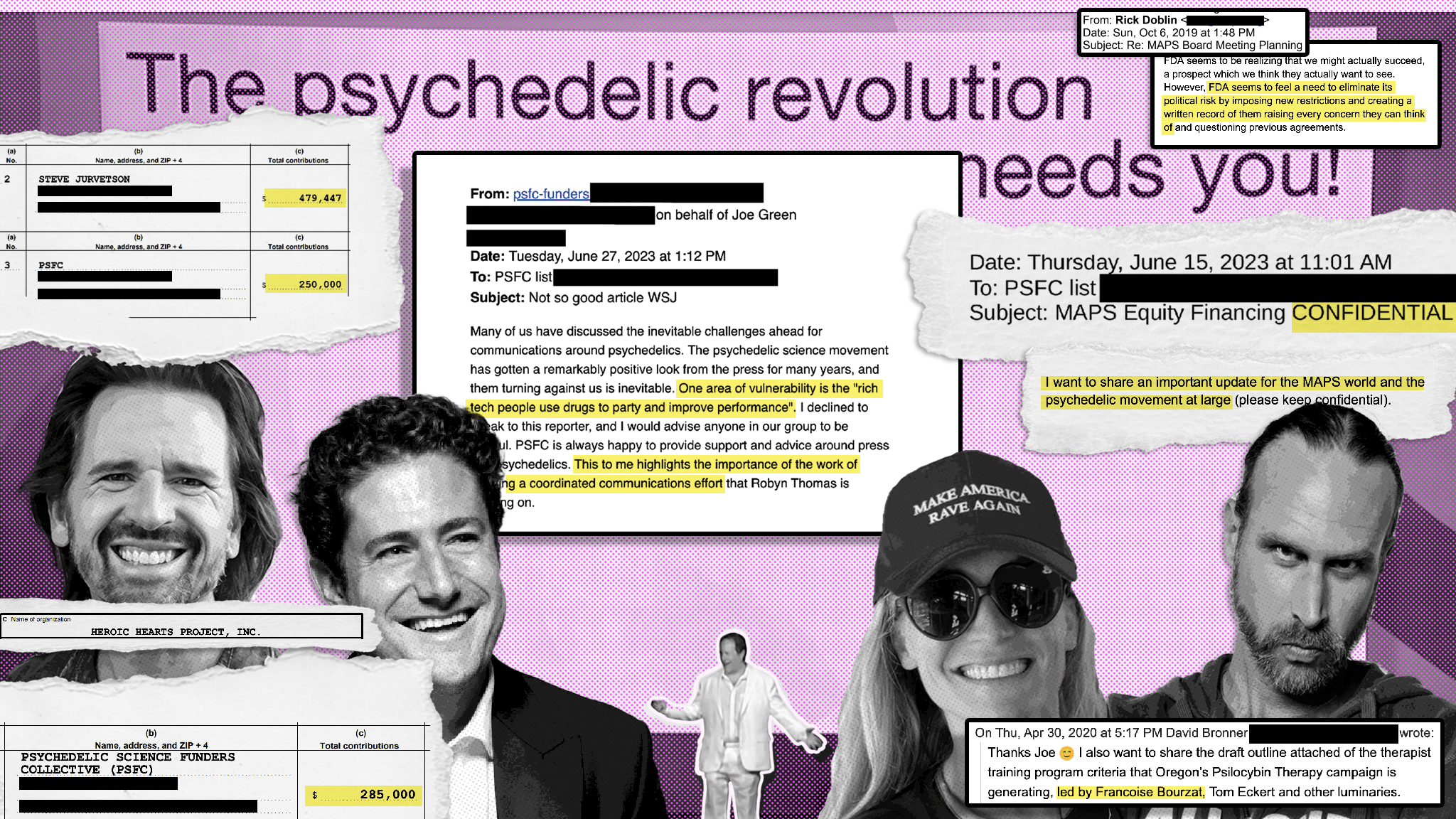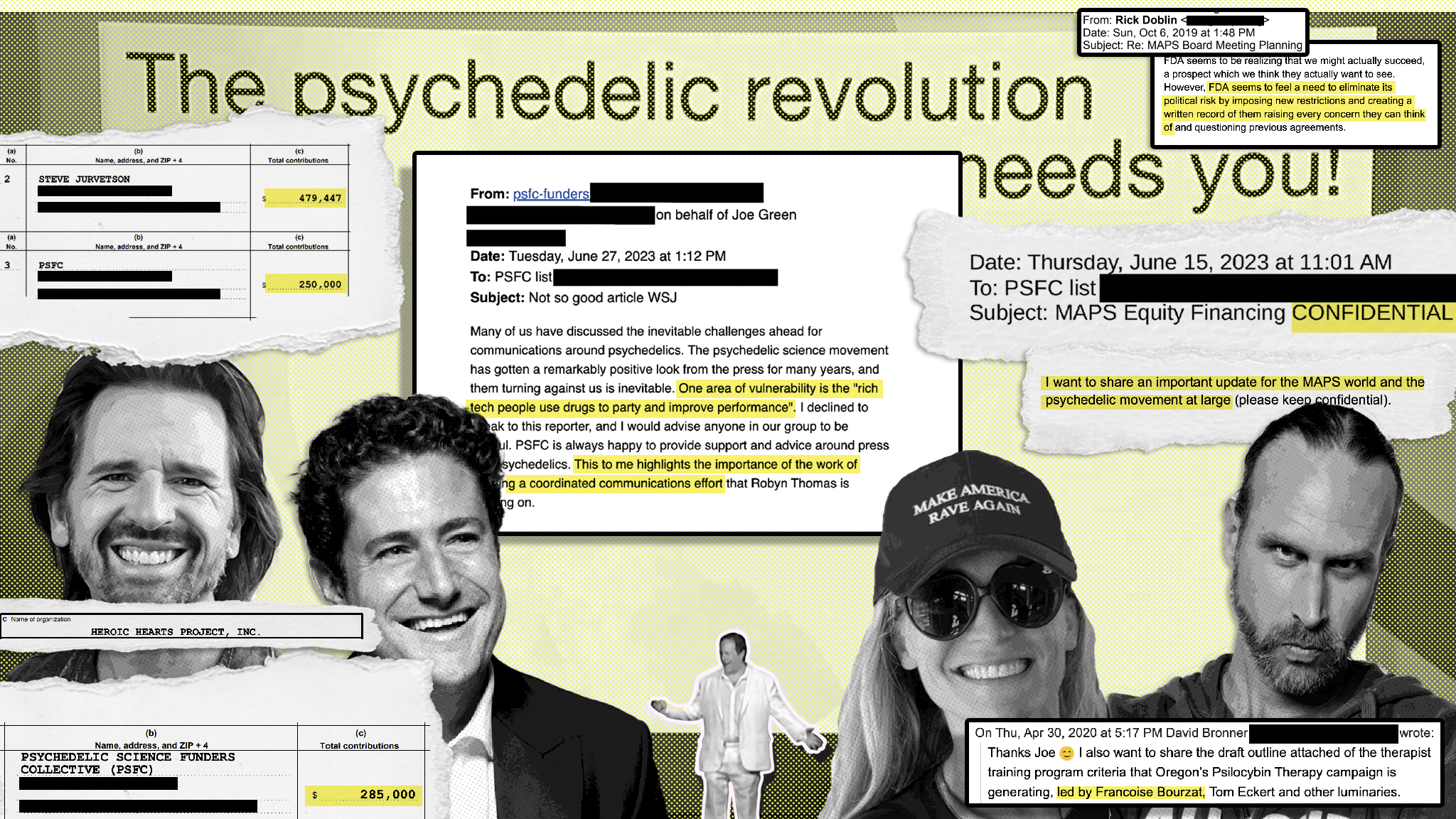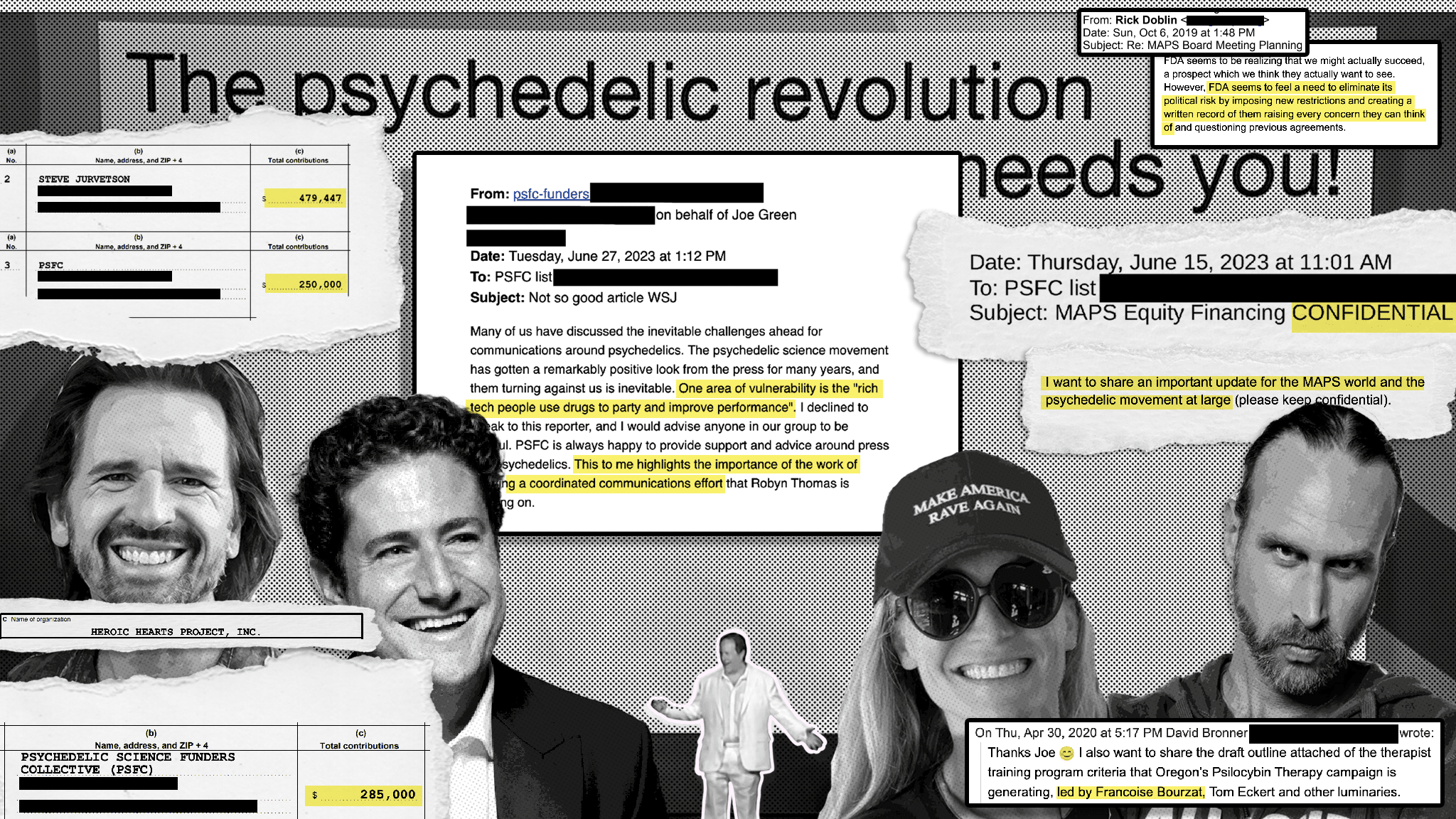
The Psychedelic Syndicate: Executive Summary
How Silicon Valley Used Veterans to Hijack the Psychedelic Industry
Principal authors: Neşe Devenot, PhD; Russell Hausfeld; Brian Pace, PhD; and Brian Normand. Contributing authors: Meaghan Buisson and James Curtis.
Part 1 | Part 2 | Part 3 | Part 4 | Primary Documents | Download PDF
A year-long investigation reveals how a small group of Silicon Valley elites sought to capture the psychedelic therapy industry — using a network of affiliated organizations to scapegoat critics while pressuring regulators to approve their botched MDMA clinical trials.
Executive Summary
This report provides an in-depth examination of how a strategic, well-funded campaign operated to influence public perception at the expense of public health.
Psymposia has spent over a year investigating the financial and political forces shaping the psychedelic industry. Through analysis of hundreds of internal documents — including emails, transcripts, presentations, and other primary materials spanning nearly a decade — this report describes the rise of the Psychedelic Science Funders Collaborative (PSFC) and its extensive influence across the field.
Every claim has undergone rigorous pre-publication legal review. Psymposia received legal support from ProJourn, an innovative pro bono program operated by the Reporters Committee for Freedom of the Press. Psymposia is a member of Reporters Shield, an organization developed by investigative journalists at the Organized Crime and Corruption Reporting Project and lawyers at the Cyrus R. Vance Center for International Justice, which defends investigative reporting around the world from legal threats meant to silence critical voices.
The prevailing media narrative has characterized the psychedelic movement as an organic coalition of grassroots activists motivated by psychedelics’ therapeutic potential. Our analysis reveals PSFC’s coordinated efforts to circumvent federal regulatory structures and manipulate state-level policy development, transforming a community-led movement into a vehicle for centralized corporate influence.
PSFC has established control by occupying the boards of strategic organizations, spearheading state-level policy initiatives, and funding psychedelic research centers at major universities across the United States. This coordinated effort aimed to establish a multi-billion dollar psychedelic pharmaceutical industry, with Lykos Therapeutics’ MDMA-assisted therapy serving as the crucial first approval. (Lykos has since rebranded to Resilient Pharmaceuticals.)
Following the FDA’s 2024 rejection of MDMA-assisted therapy, PSFC-funded organizations targeted critics and whistleblowers in collaboration with the Psychedelic Communications Hub (now incorporated into the Psychedelic Safety Institute). Organizations involved in this campaign included the Multidisciplinary Association for Psychedelic Studies (MAPS), Lykos Therapeutics, and veterans groups Heroic Hearts Project and Healing Breakthrough.
Having failed to subvert the FDA regulatory process, these groups are now appealing to the Trump administration to accelerate approval based on data from clinical trials characterized by serious scientific failures. Disregarding public safety concerns in their rush to bring an experimental therapy to market, PSFC responded to the FDA’s rejection by intensifying strategies that would amount to regulatory capture.
In releasing this report, our goal is to provide the public with a clearer understanding of the financial influences at play within the psychedelic industry and to create a resource for researchers and reporters.
Psymposia would like to thank the numerous whistleblowers, sources, lawyers, and researchers who contributed to this report. Many contributors remain anonymous due to the dynamics outlined in this report.
Chapter Overview
Chapter 1: A “Bulwark Against Backlash”
In August 2024, the FDA rejects Lykos Therapeutics’ application for MDMA-assisted therapy following an advisory committee’s recommendation against approval due to flawed clinical trials. With over $100 million at stake, Lykos funders launch a crisis response campaign using proxy veteran advocacy groups to deflect criticism and pressure regulators, exploiting public sympathy for veterans while spreading disinformation about critics.
Chapter 2: The House That Rick Built
The Multidisciplinary Association for Psychedelic Studies (MAPS) spent decades attempting to commercialize MDMA-assisted therapy. When philanthropic funding dried up after 2020 and Phase 3 trial costs ballooned, MAPS faced a budget shortfall and turned to the Psychedelic Science Funders Collaborative (PSFC) to get MDMA to market.
Chapter 3: “The Psychedelic Domino That Tips All Others”
This chapter describes PSFC’s origins, motivations, and structure, tracing its development into a highly networked organization with plans to control the entire field. PSFC defines a three-pronged strategy: get FDA approval for MDMA therapy as a catalyst, legalize psilocybin at the state level to scale up therapist training, and eventually secure federal approval for psilocybin.
Chapter 4: “From Start-Up to Grown Up”
Behind the scenes at Psychedelic Science 2023, PSFC’s leadership orchestrates a corporate takeover of MAPS PBC through private equity funding, diminishing founder Rick Doblin’s power as the organization transforms into a traditional pharma company. To counter negative press coverage of psychedelics, PSFC’s network develops initiatives to control the psychedelic narrative, including funding journalist training programs and supporting the development of a “coordinated communications effort.”
Chapter 5: “With Passion But Not Savvy”
With their Landscape Report serving as a blueprint for taking control of the psychedelic field, PSFC dismisses grassroots efforts as “scattershot” while positioning themselves as the necessary coordinator with “political expertise.” To execute this plan, the organization strategically invests in underground therapist trainer Françoise Bourzat to help scale psychedelic therapy training globally, particularly through the Oregon Psilocybin Services initiative where she influenced training standards for the legal market.
Chapter 6: “The Dangerous Virus of Silicon Valley”
PSFC holds an exclusive summit in May 2021 at billionaire member Steve Jurvetson’s beach house to launch their Landscape Report, featuring politicians and psychedelic leaders including underground trainer Françoise Bourzat. Months later, revelations emerge that Bourzat’s husband Aharon Grossbard is allegedly the abusive underground guide “Andrei” featured in Michael Pollan’s book, exposing decades of sexual abuse and ethical violations within the training network that PSFC is promoting to scale psychedelic therapy.
Chapter 7: “Flood the Zone”
PSFC and Lykos launch a coordinated disinformation campaign after the FDA advisory committee rejects MDMA therapy, using PR firms and veterans groups to spread false narratives that blame critics for veteran suicides. The campaign employs dehumanizing rhetoric that results in death threats and harassment against Psymposia members, while coordinating messaging through the Psychedelic Communications Hub to deflect attention from Lykos’ clinical trial failures.
Chapter 8: “The One Guy Who Voted Yes”
While investigating the veterans groups that testified at the FDA advisory committee, Psymposia discovers the Veteran Mental Health Leadership Coalition (VMHLC), which co-founder Brett Waters had pitched to PSFC as a lobbying force capable of influencing federal policy. The investigation reveals that Dr. Walter Dunn — the sole advisory committee member who voted “yes” on the safety of Lykos’ application — served on VMHLC’s advisory board alongside Waters and failed to disclose this conflict of interest.
Chapter 9: “It Means They Dodged a Bullet”
Despite Dr. Walter Dunn’s expertise on how institutional betrayal compounds trauma in veterans, he ignores evidence that MAPS/Lykos perpetuates the same institutional betrayal through abusive therapy practices. The psychedelic industry follows Silicon Valley’s “accelerationist” philosophy that dismisses safety concerns as obstacles to innovation, creating a culture where harmful treatment practices are systematically recast as therapeutic breakthroughs.
Chapter 10: “Avalanche”
Multiple safeguards fail when Meaghan Buisson reports abuse during MAPS’s Phase 2 trial to the IRB and FDA, with neither responding adequately to her warnings that the abuse resulted from MAPS’ pseudoscientific therapy protocol. The therapy model enables abuse by training therapists to believe they can telepathically “attune” to patients and physically reenact trauma while dismissing patient distress as part of the healing process.
Chapter 11: “Make America Rave Again”
PSFC’s leadership pivots to supporting the Trump administration after losing control of the psychedelic narrative and Genevieve Jurvetson sets a “moonshot” goal for MDMA approval without additional trials. Andrew Jacobs and Rachel Nuwer write an article for the The New York Times that labels Psymposia as “a Leftist Activist Group That Helped Torpedo” Lykos’ chances at the FDA. Meanwhile, Elon Musk ally Antonio Gracias seizes control of the company and RFK Jr. promises rapid psychedelic access as HHS Secretary.
Chapter 12: “Wound Becomes Portal”
At Burning Man 2023, Steve Jurvetson promotes a massive art installation called “Chalice to Eleusis” featuring 1,000 drones animating religious motifs, representing PSFC’s interest in reengineering religion as an alternative path to psychedelic legitimacy. PSFC funds psychedelic humanities programs at Harvard and Berkeley while members are implicated in ethically compromised research like the Johns Hopkins religious leaders study.
Chapter 13: “This Pattern is Likely to Continue”
PSFC releases a new “Strategic Roadmap” in 2025 seeking $125 million to fund coordinated messaging through proxy organizations, while positioning itself as the solution to high-profile ethical violations at organizations that PSFC’s network had funded. The strategy includes supporting the Psychedelic Safety Institute (PSI) as a “nonprofit strategy lab” that developed a template for industry-wide ethical standards based on Gather Well Psychedelics (a new organization promoting Bourzat’s lineage) despite documented patterns of abuse.
Afterword: Epitaph
Steve Jurvetson envisions a future where AI handles psychedelic therapy while humans serve as “lowest-cost labor,” representing the dangerous convergence of psychedelics, AI, and surveillance technologies under Silicon Valley control. The psychedelic revolution is being hijacked by the same billionaire forces that created the crises it claims to solve, with key figures promoting both psychedelic access and far-right ideologies. The report concludes with an analysis of what this concentrated wealth and influence means for the future of psychedelic medicine, calling for greater transparency, accountability, and genuine community involvement in shaping the psychedelic field.
The Psychedelic Syndicate: Part 1
October 10, 2025
Part 1 of The Psychedelic Syndicate reveals how the Psychedelic Science Funders Collaborative (PSFC) — a wealthy network of Silicon Valley elites and Burning Man devotees — systematically captured the psychedelic movement by influencing MAPS, funding its subsidiary Lykos’ MDMA clinical trials, and promoting underground therapy through state legalization initiatives.
The Psychedelic Syndicate: Part 2
October 10, 2025
Part 2 of The Psychedelic Syndicate exposes the compromised foundation of PSFC's influence network — from the abuse scandals that undermined their preferred therapy model, to undisclosed ties with the sole FDA advisory committee member who voted unequivocally for MDMA approval.
The Psychedelic Syndicate: Part 3
October 10, 2025
Part 3 of The Psychedelic Syndicate exposes how Silicon Valley's "move fast and break things" mentality infected psychedelic therapy, creating a culture where leaders rationalized patient harm as unavoidable for progress and ultimately embraced Trump administration officials who promised regulatory shortcuts.
The Psychedelic Syndicate: Part 4
October 10, 2025
Part 4 of The Psychedelic Syndicate reveals PSFC’s strategy to manufacture spiritual and moral authority through academic capture — even as some members align with far-right ideologies that deepen the very crises psychedelics are meant to heal.
The Psychedelic Syndicate: Selected Primary Source Documents
This appendix makes available numerous previously unreleased primary source documents to serve as resources for other researchers and reporters.
